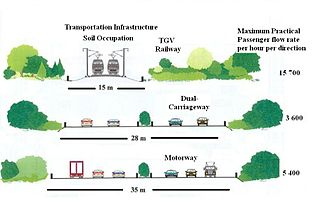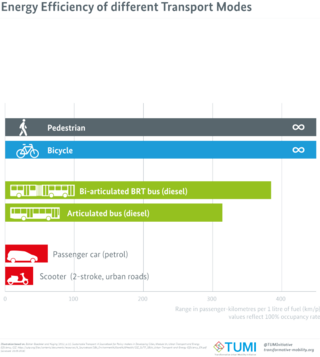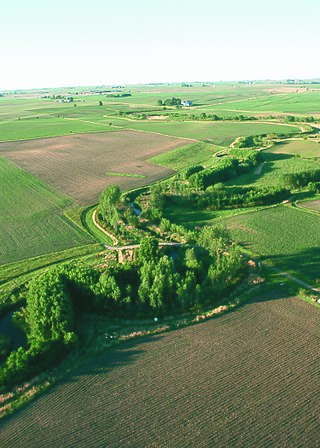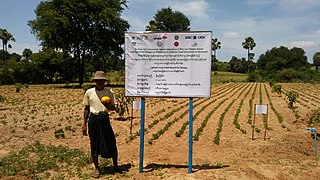Related Research Articles

Sanitation refers to public health conditions related to clean drinking water and treatment and disposal of human excreta and sewage. Preventing human contact with feces is part of sanitation, as is hand washing with soap. Sanitation systems aim to protect human health by providing a clean environment that will stop the transmission of disease, especially through the fecal–oral route. For example, diarrhea, a main cause of malnutrition and stunted growth in children, can be reduced through adequate sanitation. There are many other diseases which are easily transmitted in communities that have low levels of sanitation, such as ascariasis, cholera, hepatitis, polio, schistosomiasis, and trachoma, to name just a few.

Sustainable urban infrastructure expands on the concept of urban infrastructure by adding the sustainability element with the expectation of improved and more resilient urban development. In the construction and physical and organizational structures that enable cities to function, sustainability also aims to meet the needs of the present generation without compromising the capabilities of the future generations.

Sustainable sanitation is a sanitation system designed to meet certain criteria and to work well over the long-term. Sustainable sanitation systems consider the entire "sanitation value chain", from the experience of the user, excreta and wastewater collection methods, transportation or conveyance of waste, treatment, and reuse or disposal. The Sustainable Sanitation Alliance (SuSanA) includes five features in its definition of "sustainable sanitation": Systems need to be economically and socially acceptable, technically and institutionally appropriate and protect the environment and natural resources.

In ecology, resilience is the capacity of an ecosystem to respond to a perturbation or disturbance by resisting damage and subsequently recovering. Such perturbations and disturbances can include stochastic events such as fires, flooding, windstorms, insect population explosions, and human activities such as deforestation, fracking of the ground for oil extraction, pesticide sprayed in soil, and the introduction of exotic plant or animal species. Disturbances of sufficient magnitude or duration can profoundly affect an ecosystem and may force an ecosystem to reach a threshold beyond which a different regime of processes and structures predominates. When such thresholds are associated with a critical or bifurcation point, these regime shifts may also be referred to as critical transitions.
The Global Water Partnership (GWP) is an international network created to foster an integrated approach to water resources management (IWRM) and provide practical advice for sustainably managing water resources. It operates as a network, open to all organisations, including government institutions, agencies of the United Nations, bi- and multi-lateral development banks, professional associations, research institutions, non-governmental organisations, and the private sector.
Water resources are natural resources of water that are potentially useful for humans, for example as a source of drinking water supply or irrigation water. These resources can be either freshwater from natural sources, or water produced artificially from other sources, such as from reclaimed water (wastewater) or desalinated water (seawater). 97% of the water on Earth is salt water and only three percent is fresh water; slightly over two-thirds of this is frozen in glaciers and polar ice caps. The remaining unfrozen freshwater is found mainly as groundwater, with only a small fraction present above ground or in the air. Natural sources of fresh water include surface water, under river flow, groundwater and frozen water. People use water resources for agricultural, industrial and household activities.

The aim of water security is to make the most of water's benefits for humans and ecosystems. The second aim is to limit the risks of destructive impacts of water to an acceptable level. These risks include for example too much water (flood), too little water or poor quality (polluted) water. People who live with a high level of water security always have access to "an acceptable quantity and quality of water for health, livelihoods and production". For example, access to water, sanitation and hygiene services is one part of water security. Some organizations use the term water security more narrowly for water supply aspects only.
Integrated urban water management in Aracaju, the capital city of the Brazilian State of Sergipe (SSE) has been and still is a challenging prospect. Home to half a million people, Aracaju is located in a tropical coastal zone within a semi-arid state and receives below average rainfall of 1,200 mm/year where average rainfall in Latin America is higher at 1,556 mm/yr. Most of the residents do have access to the potable water supply and non-revenue water losses are nearly 50%.

Integrated urban water management (IUWM) is the practice of managing freshwater, wastewater, and storm water as components of a basin-wide management plan. It builds on existing water supply and sanitation considerations within an urban settlement by incorporating urban water management within the scope of the entire river basin. IUWM is commonly seen as a strategy for achieving the goals of Water Sensitive Urban Design. IUWM seeks to change the impact of urban development on the natural water cycle, based on the premise that by managing the urban water cycle as a whole; a more efficient use of resources can be achieved providing not only economic benefits but also improved social and environmental outcomes. One approach is to establish an inner, urban, water cycle loop through the implementation of reuse strategies. Developing this urban water cycle loop requires an understanding both of the natural, pre-development, water balance and the post-development water balance. Accounting for flows in the pre- and post-development systems is an important step toward limiting urban impacts on the natural water cycle.

WASH is a sector focused on providing water, sanitation and hygiene services. It aims to achieve public health gains, uphold the human right to water and sanitation, reduce the burden of collecting drinking water, and improve health and education outcomes. Access to WASH services is critical for sustainable development and is integral to achieving Sustainable Development Goal 6, which targets equitable access to water and sanitation for all. Services provided by WASH are useful for development in areas without proper sanitation services

Urban resilience has conventionally been defined as the "measurable ability of any urban system, with its inhabitants, to maintain continuity through all shocks and stresses, while positively adapting and transforming towards sustainability".

Sustainable urbanism is both the study of cities and the practices to build them (urbanism), that focuses on promoting their long term viability by reducing consumption, waste and harmful impacts on people and place while enhancing the overall well-being of both people and place. Well-being includes the physical, ecological, economic, social, health and equity factors, among others, that comprise cities and their populations. In the context of contemporary urbanism, the term cities refers to several scales of human settlements from towns to cities, metropolises and mega-city regions that includes their peripheries / suburbs / exurbs. Sustainability is a key component to professional practice in urban planning and urban design along with its related disciplines landscape architecture, architecture, and civil and environmental engineering. Green urbanism and ecological urbanism are other common terms that are similar to sustainable urbanism, however they can be construed as focusing more on the natural environment and ecosystems and less on economic and social aspects. Also related to sustainable urbanism are the practices of land development called Sustainable development, which is the process of physically constructing sustainable buildings, as well as the practices of urban planning called smart growth or growth management, which denote the processes of planning, designing, and building urban settlements that are more sustainable than if they were not planned according to sustainability criteria and principles.
Climate resilience is a concept to describe how well people or ecosystems are prepared to bounce back from certain climate hazard events. The formal definition of the term is the "capacity of social, economic and ecosystems to cope with a hazardous event or trend or disturbance". For example, climate resilience can be the ability to recover from climate-related shocks such as floods and droughts. Different actions can increase climate resilience of communities and ecosystems to help them cope. They can help to keep systems working in the face of external forces. For example, building a seawall to protect a coastal community from flooding might help maintain existing ways of life there.

Smart Green Resilient, also known as SGR, refers to an emerging planning approach that aims to enable pragmatic concerns to be addressed simultaneously with major environmental issues and to structure long-term resilience in urban planning strategies, masterplans and sustainability frameworks for a wide range of contexts. SGR was developed in the Arup Hong Kong office and is derived from design practice, observations and collective research on East Asia’s energetic urbanisation and is now regarded as a key component of Hong Kong's city strategy.

Nature-based solutions describe the development and use of nature (biodiversity) and natural processes to address diverse socio-environmental issues. These issues include climate change mitigation and adaptation, human security issues such as water security and food security, and disaster risk reduction. The aim is that resilient ecosystems provide solutions for the benefit of both societies and biodiversity. The 2019 UN Climate Action Summit highlighted nature-based solutions as an effective method to combat climate change. For example, nature-based systems for climate change adaptation can include natural flood management, restoring natural coastal defences, and providing local cooling.

Climate change education (CCE) is education that aims to address and develop effective responses to climate change. It helps learners understand the causes and consequences of climate change, prepares them to live with the impacts of climate change and empowers learners to take appropriate actions to adopt more sustainable lifestyles. Climate change and climate change education are global challenges that can be anchored in the curriculum in order to provide local learning and widen up mindset shifts on how climate change can be mitigated. In such as case CCE is more than climate change literacy but understanding ways of dealing with climate

Sustainable Development Goal 6 declares the importance of achieving "clean water and sanitation for all". It is one of the 17 Sustainable Development Goals established by the United Nations General Assembly to succeed the former Millennium Development Goals (MDGs). According to the United Nations, the overall goal is to: "Ensure availability and sustainable management of water and sanitation for all." The goal has eight targets to be achieved by 2030 covering the main areas of water supply and sanitation and sustainable water resource management. Progress toward the targets will be measured by using eleven indicators.

Climate-smart agriculture (CSA) is a set of farming methods that has three main objectives with regards to climate change. Firstly, they use adaptation methods to respond to the effects of climate change on agriculture. Secondly, they aim to increase agricultural productivity and to ensure food security for a growing world population. Thirdly, they try to reduce greenhouse gas emissions from agriculture as much as possible. Climate-smart agriculture works as an integrated approach to managing land. This approach helps farmers to adapt their agricultural methods to the effects of climate change.

Sustainable Development Goal 11, titled "sustainable cities and communities", is one of 17 Sustainable Development Goals established by the United Nations General Assembly in 2015. The official mission of SDG 11 is to "Make cities inclusive, safe, resilient and sustainable". The 17 SDGs take into account that action in one area will affect outcomes in other areas as well, and that development must balance social, economic and environmental sustainability.
Integrated Flood Management (IFM) is an approach to managing floods that emphasizes collaboration among various stakeholders, disciplines, and sectors concerned with floods, i.e. integrating them. IFM is a component of Integrated Water Resources Management (IWRM) and was developed as more holistic approach compared to the concept of flood control. While flood control aims mainly on reducing or preventing the negative effects of floods, IFM aims on reducing the overall risk by means of land and water resources management with the goal of maximizing the benefits from the use of flood plains and minimizing the damage and loss of life due to flooding in a sustainable manner.
References
- 1 2 3 "One Water - The Watershed Association". 2018-07-13. Retrieved 2023-12-09.
- ↑ Tuser, Cristina (2021-09-09). "What is One Water?". Wastewater Digest. Retrieved 2023-12-08.
- ↑ "One Water in the Texas Hill Country | Welcome to Hill Country Alliance". hillcountryalliance.org. Retrieved 2023-12-08.
- 1 2 "Environmental Engineering, BS". University of Illinois Urbana-Champaign . Retrieved 4 January 2024.
- ↑ "Welcome to IWRM Action Hub!". Global Water Partnership. Retrieved 2023-12-09.
- 1 2 ""One Water" Approach for Improvement in Water Resource Management - Environmental Finance Center Network". 2020-03-24. Retrieved 2023-12-09.
- ↑ Tuser, Cristina (2021-09-09). "What is One Water?". Wastewater Digest. Retrieved 2023-12-09.
- 1 2 3 Lenz, Jeremy (2018-04-28). "One Water: A New Era in Water Management". Open Rivers Journal. Retrieved 2023-12-09.
- ↑ Jiang, Albert Z.; McBean, Edward A. (January 2021). "Sponge City: Using the "One Water" Concept to Improve Understanding of Flood Management Effectiveness". Water. 13 (5): 583. doi: 10.3390/w13050583 . ISSN 2073-4441.
- ↑ "WHO/UNICEF Joint Monitoring Program for Water Supply, Sanitation and Hygiene (JMP) - Progress on household drinking water, sanitation and hygiene 2000 - 2020". UN-Water. Retrieved 2023-12-09.
- ↑ U.S. Environmental Protection Agency (April 18, 2023). "Tools and Resources for Climate Resilience Planning Utilizing a One Water Approach". Environmental Protection Agency www.epa.gov.
- ↑ "One Water Council". US Water Alliance. Retrieved 2023-12-08.
- ↑ "The Value of Water Campaign". US Water Alliance. Retrieved 2023-12-08.
- ↑ "One Water". Resilience Office - City and County of Honolulu Office of Climate Change, Sustainability and Resiliency. Retrieved 2023-12-08.
- ↑ "Affordable Water, Resilient Communities(TM)". www.affordableh2o.org. Retrieved 2023-12-08.
- ↑ "One Water". www.semcog.org. Retrieved 2023-12-09.
- ↑ "One Water Cities: Development of Guidance Documents and Assessment Metrics". The Water Research Foundation. 2024-01-17. Retrieved 2023-12-09.
- ↑ "Cities of the Future". International Water Association. Retrieved 2023-12-09.
- ↑ "One Water LA 2040 Plan". LA City. 2023.
- ↑ "One Water Plan City of Palo Alto".
- ↑ "OneWaterSF". sfpuc.org. Retrieved 2023-12-09.
- ↑ Emmer, Olivia. "Denver Adopts One Water". Water Education Colorado. Retrieved 2023-12-09.
- ↑ "Denver One WAter Plan" (PDF).
- ↑ "One Water Plan". Wake County Government. Retrieved 2023-12-09.
- ↑ "Oe Water Wake County" (PDF).
- ↑ "#onewaterourwater". #onewaterourwater. Retrieved 2023-12-09.
- ↑ Vancouver, City of. "One Water". vancouver.ca. Retrieved 2023-12-09.
- ↑ "One Water". Resilience Office - City and County of Honolulu Office of Climate Change, Sustainability and Resiliency. Retrieved 2023-12-09.
- ↑ "A "One Water" Future for America's Cities". National League of Cities. 2017-09-25. Retrieved 2023-12-09.
- ↑ Akhtar, Salman (2023-12-04). "Kazakhstan and France Unveil Plans for One Water Summit in 2024". BNN Breaking. Retrieved 2023-12-09.